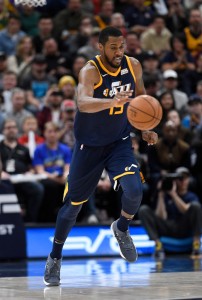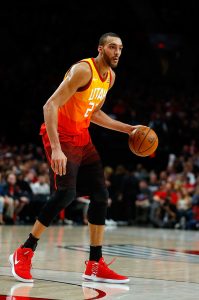Losing a homegrown All-Star like Gordon Hayward in free agency last summer could have set the Jazz back years. Instead, it only set them back by three regular-season wins, as the club returned to the postseason and once again advanced to the second round before being bounced from the playoffs.
It was a very encouraging year for the Jazz, showing they’d be able to withstand the loss of a franchise cornerstone without slipping back into the lottery. Rookie guard Donovan Mitchell helped smooth the transition to the post-Hayward era, emerging as a long-term building block in his own right. Now, Utah will have to figure out what roster moves are necessary to give the franchise a better chance at making a slightly deeper playoff run.
Here are five key questions facing the Jazz this summer:
1. Will the Jazz re-sign Derrick Favors?
For a time, it seemed as if a frontcourt combination of Favors and Rudy Gobert simply wasn’t compatible, with Favors struggling to make an impact alongside Gobert and thriving when given a chance to handle the center position on his own. However, Quin Snyder and the Jazz made it work in the second half of the 2017/18 season.
In Favors, the Jazz have not only a reliable backup center for Gobert who can step in and play starter minutes in the event of an injury, but a power forward capable of matching up with other teams’ two-big lineups. Neither Favors nor Gobert can shoot from beyond the arc, but Favors has a mid-range game that stretches the floor to some extent, and as long as they’re on the court with two or three other players capable of hitting threes, it seems to work.
Assuming Utah is confident that the pairing can continue to have success, I’d expect the club to make a strong effort to re-sign Favors as a free agent this summer. If the Jazz have the opportunity to land a versatile impact player at the four, the team could let Favors walk and look to add a more affordable backup center separately, but if not, the Jazz have the cap flexibility to outbid teams that only have the mid-level exception available. It wouldn’t be a surprise to see Favors land a deal worth slightly more than the MLE — perhaps three years for $30-35MM.
2. Will Dante Exum‘s time in Utah continue?
Selected right after Joel Embiid and Aaron Gordon and right before Marcus Smart and Julius Randle in the 2014 draft, Exum is perhaps the only player in that group who isn’t assured a big payday this summer. Various injuries have limited him to 80 regular-season games in the last three seasons, but Exum is still just 22 years old, and flashed tantalizing play-making potential when he got healthy down the stretch in 2017/18.
With Ricky Rubio under contract for one more season and Raul Neto also eligible for restricted free agency this summer, Utah’s long-term outlook at the point guard spot is somewhat hazy. As such, it might make sense for the club to invest in Exum on a sort of a bridge deal for two or three years. If he stays healthy and keeps improving, he could be a ready for a bigger role by the time Rubio’s contract expires. If he continues to battle injuries and fails to make major strides, then the Jazz can get out from under his deal before too long.
Finding a price point that works for both Exum and the Jazz could be a challenge. Near the end of the regular season, one front office executive estimated that a two-year offer worth a total of $18-20MM might be enough for a rival team to pry the former fifth overall pick out of Utah, and I wouldn’t be shocked if a team drew up an offer sheet even more aggressive than that. A team like the Suns, for instance, could afford to roll the dice on a young player like Exum developing into their point guard of the future.
If an offer sheet of that caliber doesn’t materialize, the Jazz should be able to retain Exum on a more reasonable deal, perhaps in the range of $7-8MM per year.
3. How can the Jazz avoid simply running back last year’s roster?
If the Jazz do re-sign Favors and Exum to salaries in the neighborhood of my estimates, it would likely eliminate the team’s chances at cap room. That would leave the mid-level exception as the club’s best tool for adding a key rotation player.
Utah could use some offensive help, perhaps at shooting guard or small forward, and there should be a handful of free agents out there who fit that bill and would sign at a mid-level rate. But would any of them move the needle substantially for the Jazz, taking the franchise from a solid playoff team to a legit title contender? Probably not.
It may be unreasonable to expect the Jazz to take a big step toward serious championship contention this summer, considering the sort of competition they’re up against in the Western Conference, but if that sort of difference-making player is out there, the team will probably find him on the trade market rather than in free agency. Taking that into account, I’d expect the Utah front office to be very active in trade talks this summer.
4. Who are Utah’s best trade chips?
Gobert and Mitchell are the foundation pieces in Utah, and won’t be going anywhere. It’s possible that the team would part with Rubio, Joe Ingles, or Jae Crowder in the right deal, but those players thrived with the Jazz last season and are good fits on the roster going forward. I wouldn’t expect them to be dealt.
Of the players on guaranteed contracts, that leaves a pair of potential trade candidates. One is second-year center Tony Bradley, who appeared in just nine NBA games in his rookie season. Bradley played well in the G League, averaging a double-double in 24 games, but he’s still probably not ready for a regular role — there may not be a regular role available at the five for the foreseeable future in Utah if Favors is re-signed, so Bradley certainly shouldn’t be untouchable.
From a salary-matching perspective, the more logical trade chip is Alec Burks, who will earn about $11.5MM in 2018/19. Burks has shown promise during his seven seasons in Utah and has even been a productive contributor at times, but his health has been an ongoing issue and he’s not a crucial part of the rotation. His contract will expire in 2019, which could appeal to potential trade partners, even if they don’t envision a huge role for him.
Outside of Burks and Bradley, Utah could use draft picks as sweeteners in a trade offer for an impact player. If they prefer to keep their 2018 first-rounder (No. 21 overall) to add a low-cost wing to replace Burks, the Jazz could wait until after the draft, then dangle any of their future first-rounders, including 2019’s. The club also has a couple extra second-rounders coming its way in 2021 and 2022, which could be expendable.
5. What will happen with the players on non-guaranteed contracts?
Burks’ $11.5MM salary is a good start for salary matching, but it wouldn’t be enough for many of Utah’s potential trade targets. For instance, if the Jazz want to make a play for Wizards three-and-D wing Otto Porter, they’d need to send out over $20MM in salary.
In order to reach that figure without giving up any of their most important contributors, the Jazz could include some combination of their players on non-guaranteed contracts. Currently, Thabo Sefolosha ($5.25MM), Jonas Jerebko ($4.2MM), Ekpe Udoh ($3.36MM), and Royce O’Neale ($1.38MM) don’t have guarantees for 2018/19.
O’Neale, one of the NBA’s best bargains for the next two years, almost certainly won’t be going anywhere, but the other three veterans could be trade chips. All three had fairly modest roles on the Jazz last season, so it likely wouldn’t cost much to replace their production. Attaching a couple of them to Burks along with some draft picks would create an interesting trade package, particularly since they’d all be on expiring deals.
The league’s new Collective Bargaining Agreement does complicate matters to some extent — under the old system, players like Sefolosha, Jerebko, and Udoh could be used to match salaries in a trade, then waived by their new teams before their contracts became guaranteed. That’s no longer possible. As long as their contracts remain non-guaranteed, they count as $0 for salary-matching purposes in a trade, so any team acquiring them would have to guarantee those salaries.
Jerebko had a strong season in 2017/18, but Sefolosha is coming off a major injury and Udoh played pretty sparingly, so their value will be limited. Still, their salaries won’t exactly break the bank. If the Jazz end up not needing to use any of those three players in trades, there’s a chance they all return. Jerebko is probably the best best bet to be back, while Sefolosha’s future will hinge on his health. As for Udoh, he’d be expendable if the team decides it doesn’t need to spend more than the minimum for a third-string center.
Here’s where things currently stand for the Jazz financially:
Guaranteed Salary
- Rudy Gobert ($23,491,573)
- Ricky Rubio ($14,975,000)
- Joe Ingles ($13,045,455)
- Alec Burks ($11,536,515)
- Jae Crowder ($7,305,825)
- Donovan Mitchell ($3,111,480)
- Tony Bradley ($1,679,520)
- Total: $75,145,368
Player Options
- None
Team Options
- None
Non-Guaranteed Salary
- Thabo Sefolosha ($5,250,000)1
- Jonas Jerebko ($4,200,000)2
- Ekpe Udoh ($3,360,000)3
- David Stockton ($1,544,951)4
- Royce O’Neale ($1,378,242)
- Total: $15,733,193
Restricted Free Agents
- Dante Exum ($4,333,931 qualifying offer / $14,977,156 cap hold): Bird rights
- Raul Neto ($1,839,228 qualifying offer / $1,839,228 cap hold): Bird rights
- Total: $16,816,383
Unrestricted Free Agents / Other Cap Holds
- Derrick Favors ($18,000,000): Bird rights
- No. 21 overall pick ($2,056,693)
- Total: $20,056,693
Projected Salary Cap: $101,000,000
Projected Cap Room: None
- The Jazz aren’t typically major players in free agency, so our cap projection assumes they won’t make an effort to create cap room this summer. With $75MM+ in guaranteed contracts and a $2MM cap hold for their first-round pick, the Jazz would almost certainly remain an over-the-cap team if they re-sign Exum and Favors and bring back some or all of their players on non-guaranteed contracts.
- On the other hand, if the Jazz do want to clear cap space, they could do so. Their seven guaranteed salaries along with cap charges for their first-round pick and four empty roster slots would result in a total team salary of $80,527,305. That would mean more than $20MM in cap room — but it would also mean renouncing or waiving Exum, Favors, Sefolosha, Jerebko, O’Neale, and others. That’s probably not realistic.
Footnotes:
- Sefolosha’s salary becomes fully guaranteed after July 1.
- Jerebko’s salary becomes fully guaranteed after July 9.
- Udoh’s salary becomes fully guaranteed after July 9.
- Stockton’s exact contract details, including guarantee info, aren’t yet known.
Note: Rookie scale cap holds are estimates based on salary cap projections and could increase or decrease depending on where the cap lands.
Salary information from Basketball Insiders was used in the creation of this post.
The jazz are going to be one of the most intriguing teams next year
Agreed. As long as Gobert stays healthy, they have a chance. Mitchell is something special and fun to watch.
Maybe, I just don’t find them particularly exciting to watch.
I have only seen highlights from Exum so, IDK much about him. If he can break down a defense that otherwise will not be broken, I guess he’s worth 2/$19MM to have around. But that number stuck out. Can’t shoot 3s